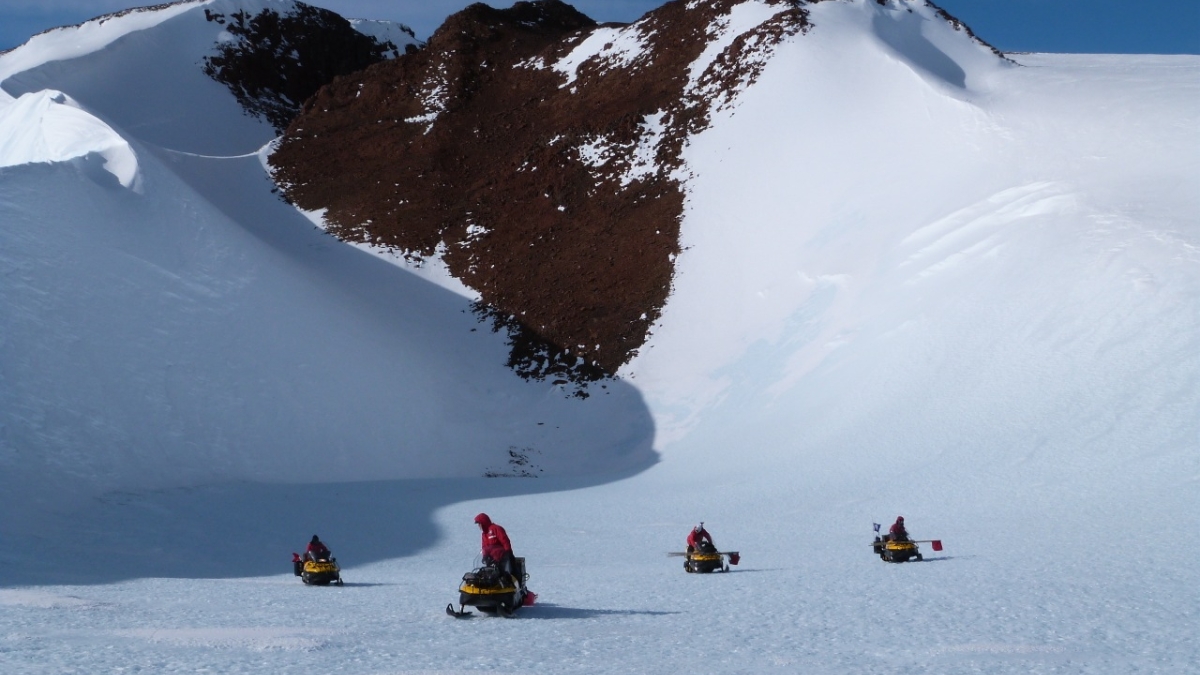Hunting for meteorites at the bottom of the world

The quest to understand the origins of the solar system and planetary formation is not an endeavor that needs a multibillion dollar price tag or a mission to the far reaches of the galaxy.
It is a quest that can be pursued at the bottom of the Earth.
The Antarctic Search for Meteorites (ANSMET) is a U.S. field project that has sent scientists to Antarctica to collect meteorites since 1976. Over the years, the program has amassed more than 20,000 meteorite samples for study, 10 times the mass of samples brought back from the Apollo missions.
Two professors from ASU’s School of Earth and Space Exploration returned recently from ANSMET’s 2012-2013 field season. Thomas Sharp and Meenakshi Wadhwa were members of the systematic search team, which contributed more than 300 meteorites to ANSMET’s collection.
Wadhwa was a team member on the 1992-1993 ANSMET trip as a graduate student from Washington University in St. Louis.
“Why do we care about rocks from space? They give us a history of the solar system,” Sharp said. “Geologists study rocks to tell us about the history of the Earth and how the Earth works. Meteorites are the rock record for the solar system.”
A meteorite is a piece of an asteroid, planet or moon that streaks through the Earth’s atmosphere, surviving the intense frictional heat and then hitting Earth’s surface. These rock fragments “are the leftovers from the planet making process” and contain clues to how planets are formed, Sharp said.
The project is carried out in Antarctica because it is an ideal place to collect meteorites.
Meteorites fall everywhere on Earth, but specimens that fall on Antarctica are well-preserved in the ice. The giant ice sheet that covers Antarctica flows like a slow-moving river, creating deposits of meteorites, a phenomenon that is unique to the continent.
As the Antarctic Ice Sheet flows from the center of the continent toward the oceans that surround it, meteorites that fell on the ice hundreds of thousands of years ago are carried with the ice sheet.
The ice is trapped behind the Transantarctic Mountains and anything buried within the ice accumulates behind the mountains. Over time the Katabatic winds, which can reach speeds of up to 200 mph, erode the ice behind the mountains, revealing the meteorites within.
The eight-person team that Wadhwa and Sharp were part of searched ice fields near the Grosvenor Mountains about 500 miles south from McMurdo Station, the U.S. research center on the southern tip of Ross Island.
The team took 25,000 pounds of gear, including tents, snow mobiles, meteorite collection equipment, solar panels, fuel, cooking stoves and food for six weeks of remote field camping.
To search for meteorites, the systematic search team lined up about 20 meters apart (about 65 feet) on snowmobiles or a few meters apart (about 5-10 feet) on foot. The team members combed the ice, stopping to inspect every rock.
On average, the team inspected a football field-sized area each day, Wadhwa said.
“When you find a meteorite you get very excited,” Wadhwa said. “You wave all your teammates over and do the collection as a team. You want to collect them as cleanly as possible to not contaminate them.”
A collection kit was provided by the Lyndon B. Johnson Space Center in Houston.
Each collected specimen’s position was recorded with GPS coordinates and a temporary flag. It was catalogued through a picture taken of the specimen next to the same kind of counter that was used on the Apollo space missions to the Moon. The specimen was then picked up with sterilized, stainless steel tools and bagged. Specimens were kept frozen until they were transported to the Johnson Space Center at the end of the season.
“Going to Mars to bring back samples would cost many, many billions of dollars,” Sharp said. “But Mars delivers us free samples.”
The Apollo missions to the Moon, which brought back nearly 850 pounds of moon rock, cost more than $150 billion in today’s currency. ANSMET’s field work, which is funded by NASA and the National Science Foundation, has cost between $30 million to $35 million over the program’s entire lifetime of 37 years, according to principal investigator Ralph Harvey, who runs the program out of Case Western Reserve University in Ohio.
“You can think about it as a poor person’s space mission,” Wadhwa said. “It’s a way of getting samples from other places in the solar system without actually sending very expensive space craft out there to look for these things.”
Although Antarctica is extremely accessible compared to the Moon, Mars or any other planetary body, it is still a fierce and foreign environment.
During the 2012-2013 field season the coldest day was about negative 25 degrees Celsius, or negative 13 degrees Fahrenheit, Sharp said. Each season typically takes place during the months of November to January, which are Antarctica’s summer months.
“There’s no life up on the plateau. There are no animals no insects, no germs no viruses and no pollution. It’s absolutely clean and sterile,” Sharp said. “It was very different from normal life.”
Sharp and Wadhwa both agreed the trip was an incredible experience.
“It’s hard to describe the excitement of finding samples from another planet or another place in the solar system,” Wadhwa said.
For more information, visit http://artscilabs.case.edu/ansmet/.
Written by Kristen Hwang

